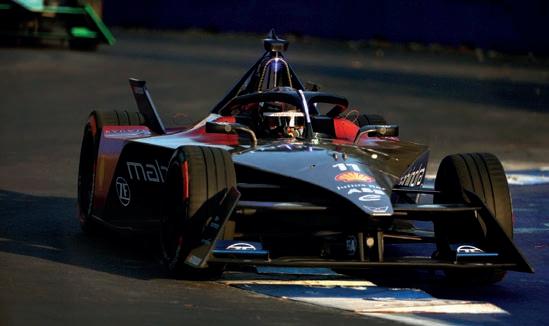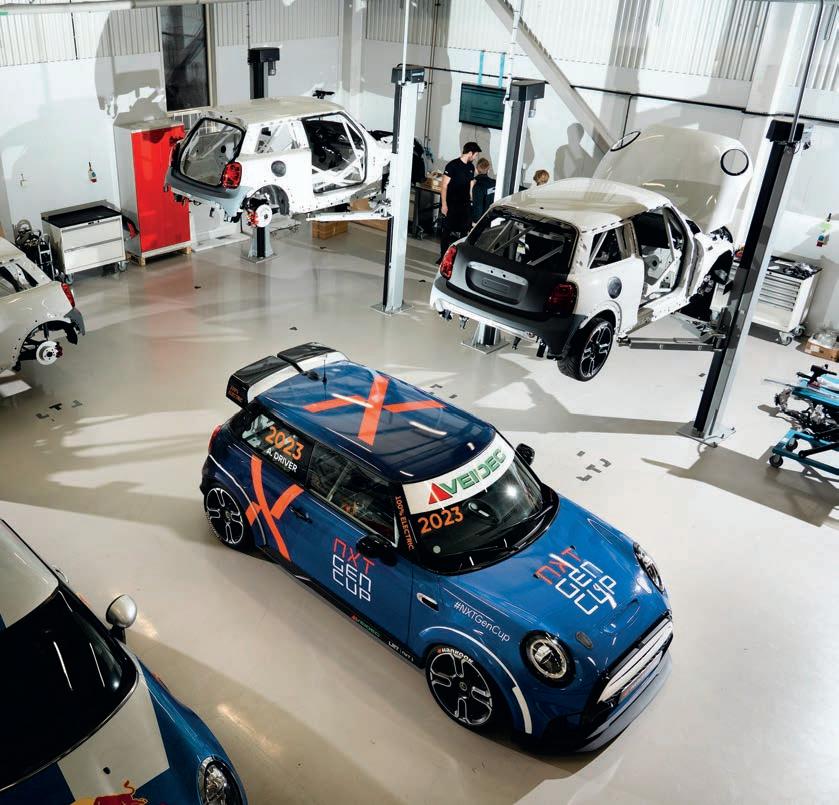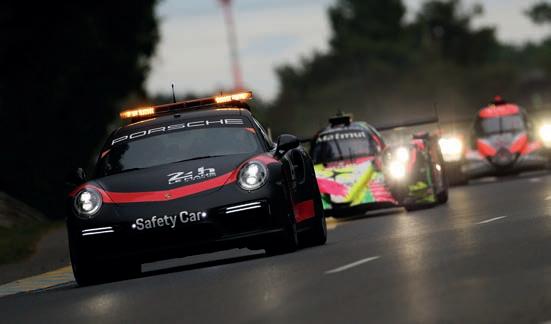
9 minute read
The power of tomorrow
With the new regulations announced, the 2026 Formula 1 power unit games have begun…
By DIETER RENCKEN
The burning question is what happens if an F1 PU brand unexpectedly departs? Who steps into the breach, and on what basis?
Schematic showing the proposed flow of energy in the Formula 1 2026 power unit regime
The FIA’s confirmation amidst the Red Bull launch (at which Ford announced it would partner the reigning champion team from 2026) outlined six power unit suppliers who registered for what is internally known as PU2026: Red Bull Powertrains (Ford); Ferrari; Mercedes AMG HPP; Renault (Alpine); Honda and Audi. Significantly, Porsche, who fell out with Red Bull in September, is not registered.
FIA president, Mohammed Ben Sulayem, commented: ‘The confirmation that there will be six power unit manufacturers competing in Formula 1 from 2026 is testament to the strength of the championship and the robust technical regulations that have been diligently created by the FIA in close collaboration with Formula 1 and the power unit manufacturers.
‘The power unit is at the forefront of technological innovation, making the future of Formula 1 more sustainable, while maintaining the spectacular racing.
‘I am grateful for the confidence of world-leading automotive manufacturers, demonstrated by their commitment to Formula 1.’
In addition, Cadillac is in the frame to join the sport, in conjunction with Andretti Autosport – founded by Michael, son of 1978 world champion Mario – should the US-based operation be accepted under the new team application process announced two days earlier by the governing body.
Five teams are said to have expressed interest and the outcome will announced after 30 June.
Badge of honour
‘Today is the first step in what we hope to be the historic entry of General Motors into F1. It’s never happened before in our history – it’s very, very exciting for us to be with Andretti,’ said the company’s president, Mark Reuss, during the preliminary announcement, made a fortnight before Ford confirmed its entry.
‘If [note] given the opportunity, GM and Cadillac will compete with the very best at the very highest levels, with passion and integrity that will continue to elevate the sport for the FIA and race fans around the world,’ he continued, before confirming to Racecar Engineering that GM’s luxury brand would likely enter F1 using another company’s power units, albeit re-badged as ‘Cadillac’.
His admission attracted condemnation from fans and teams, who accused the brand of entering F1 cheaply by arranging a supply of Renault or Honda power units and not setting up an in-house operation. Yet Ford is doing exactly that by going into partnership with Red Bull and attaching the Blue Oval to Red Bull-manufactured power units, much as Porsche had planned to do before the split.
‘We wanted something more strategic [than traditional partnerships],’ said Ford CEO, Bob Farley, who is an enthusiastic amateur racer in the USA. ‘It’s a very practical approach to entering Formula 1,’ he added. ‘I can look my shareholders, [and] the Ford family, in the eyes and say we’re being very judicious and thoughtful.’
Under PU2026, which calls for a 50 / 50 split between internal combustion engine and hybrid power, accusations of ‘badge engineering’ are in any event fallacious.
Although based on the architecture of current V6 units, which produce around 850bhp, complemented by a 160bhp hybrid contribution, under the new regulations output will be evenly split at a targeted 350kW (470bhp) from each source for a total of 700kW (940bhp).
As highlighted in the Red Bull Powertrains article starting on p6 of this edition of Racecar Engineering, the 1.6-litre V6 engines will retain essentially the same layout as they appear now, with a similar rpm limit. However, the fuel flow rate will be reduced, coinciding with a fuel energy flow rate that must not exceed 3000MJ/h. That equates to around 65kg/h, compared to the current fuel flow rate of 100kg/h.
This aims to cut power to approximately 400kW (536bhp) from the current level of approximately 630kW (850bhp), with total PU output today sitting at around 750kW (1000bhp) once the 120kW contribution of the MGU-K is accounted for.
Essentially, the internal combustion portion will be substantially de-rated, rendering it clearly less important than in F1’s past, and will no longer be a major performance differentiator. Under these circumstances, does it really matter whether it is built in England, France, Germany, Italy or Japan and / or what it says on the valve cover?
Road relevance
Both the energy store (battery) and energy recovery systems will be uprated, countering the reduction in power of the ICE. MGU-K output will be increased to 350kW, with full power available up to around 300km/h and limited to 150kW at or above 340km/h.
The new regulations have been devised with the aim of increasing the road relevance of the ERS components and have left battery cell chemistry and technology open to development (within the framework of the legal hardware) with a non-exclusivity provision in the rules.
This leaves the ERS system and related ancillaries and energy deployment / recovery software wide open for OEMs to take F1 technology to the road. That is precisely where armies of software specialists employed by various motor companies can make a crucial performance difference to power units, in turn applying lessons in road cars, be they BEV or hybrids, be they Ferraris and Mercedes or Fords and Cadillacs.
Indeed, Reuss alluded to just such a technical involvement during his media call:
‘In just a few weeks, Cadillac will begin the journey back to Le Mans by racing in the Rolex 24 at Daytona. By racing in IMSA, WEC and F1, Cadillac will have the opportunity to showcase its innovation and technology by going up against the best international luxury brands.’
That certainly implies more than just badge deep commitment.
Asked about Ford’s technical involvement in the Red Bull project, the Blue Oval’s global director of performance and motorsport, Mark Rushbrook, said to Racecar: ‘In Milton Keynes, where Red Bull’s F1 engine is located, a great foundation has been laid and construction is already underway on the building where the power plants will be assembled, where the test benches and dynamometers are located.
‘Ford Motor Company resources can be fully involved in this process, and this will be an additional beneficial factor. We immediately decided in which areas we will work – technology for the production of batteries, electric motors and the development of control software. In particular, we are talking about optimising the power unit as a whole.’
Lessons learned will undoubtedly then flow from there into Ford’s production cars and processes.
Application process
The FIA has a strict application process, which will help the association find potential teams looking to compete in the FIA Formula 1 World Championship.

All application entrants will undergo due diligence to ensure the prospective team has the necessary technical capabilities and resources, and the ability to generate and maintain a significant amount of funding to enable participation within the top level of competitive motorsport. Each team’s experience and human resources will also be evaluated.
All candidates will be required to address how they might manage the sustainability challenge, in addition to outlining plans to achieve a net zero CO2 impact by 2030. Furthermore, each prospective F1 team will also need to illustrate how it intends to achieve a positive societal impact through its participation in the sport, to help meet the mutual aims of the FIA and Formula 1 management.
Candidates will be selected once the long-term interests of the championship (and its stakeholders) have been evaluated. Teams must also adhere to certain regulations and governance arrangements. The terms of the formal application process – consisting of the complete selection criteria, applicable deadlines, legal requirements and other conditions – will be sent to teams that submit a preliminary expression of interest to the motorsport association.
The definition of new
One potential flashpoint is the sporting and financial concessions, such as additional dynamometer hours and less stringent caps during the ramp-up phase, granted to ‘New PU Manufacturers’, defined as those ‘who have not homologated PUs at least once in the period 2014-2021, or have not received any significant recent Intellectual Property from a current PU Manufacturer.’
While Audi undoubtedly qualifies on all fronts, Red Bull Powertrain’s (RBPT) acquisition of Honda’s IP after the Japanese gave notice of exit for the end of 2021 – a decision since semi-rescinded – gave rise to squabbles on two fronts. Although the IP was returned unused once the full implications of retaining the rights were understood, opponents argue that by having had sight of the IP at all, RBPT obtained unfair advantages.
In addition, RBPT assembles its current battery packs on behalf of Honda on the basis that it is cheaper, and safer, to do so in the UK rather than ship them, but the assembly has allegedly provided significant energy store experience ahead of 2026. While RBPT denies the charges, the counter is, ‘they would say that, wouldn’t they?’
Indeed, the matter eventually came to a head in early December when Ferrari, having refused to sign up to PU2026 unless RBPT’s concessions were reduced, was refused entry to a PU Working Group meeting on the basis that it had not registered by the end of November deadline. The Italian scuderia rapidly u-turned, but RBPT was also docked 10 per cent of the financial concessions. RBPT accepted a reduction, and Ferrari signed.
Who goes where?
Of greater interest than who integrates with whom on PUs, though, is the question of who goes where? With up to 12 teams in the running, should the FIA approve two of the five applicants for new grid slots, and six (or even seven) power unit brands as it follows that each will supply an average of two teams? That Ferrari, Mercedes, Renault-Alpine, Audi and Red Bull (Ford) will supply their respective teams is a given, but what happens thereafter?
Audi is expanding its Competence Center Motorsport at its Neuburg facility, ahead of the car maker entering Formula 1. A new 3000m2 building will be added at the south western end of the existing building complex and will be complete with test benches to support the development of power units for Audi’s Formula 1 entry in 2026.

The German manufacturer plans to develop and build the entire power unit for its Formula 1 effort at the Neuburg site, which will consist of an energy recovery system, electric motor, battery, highly efficient internal combustion engine and transmission. To date, around 220 employees have been recruited for the Formula 1 project at the Audi Neuburg facility, which will increase to over 300 by mid-2023.
Ferrari, meanwhile, will likely extend its technical partnership with Haas, which may also inherit Alfa Romeo support once Sauber becomes Audi, while Mercedes – a significant shareholder in the Aston Martin sports car company, granted in exchange for technical cooperation – is expected to continue its current deal with the green team.
Red Bull will obviously favour its own operations: the current series champions and AlphaTauri.
That leaves Honda seeking partners, potentially Williams and McLaren, which has a nostalgic ring to it given serial titles won with both teams, although the former could well stick to Mercedes given its close ties, with Andretti going with Cadillac’s supply as outlined. The other new team will be left facing a choice of whoever is prepared to sign a deal. If no one volunteers, the FIA is empowered to step in.
The power of eight
Much is currently being made by F1 and the FIA of up to eight automotive brands –in alphabetical order, Alfa Romeo, Alpine, Audi, Cadillac, Ferrari, Ford, Honda and Mercedes – potentially gearing up for 2026. This is all well and good (primarily for the F1 share price), but begs the crucial question: will they all stay the distance, particularly Ford and Cadillac, who will have no real hardware in the game?
Regardless of the business plans, or modus operandi under which the car companies have entered, F1’s global reach means each will have billions of eyeballs on their heavily branded engine covers. Indeed, that is one of their major reasons for entering the sport. On the flipside, one of their number will, by a process of elimination, partner the team destined to place last in the Constructors’ Championship.
Others are unlikely to see a podium in six years, and even fewer to win races. Championships? Even less. At which stage bean counters and marketeers will start to question whether F1 offers a wonderful return on investment, given the resulting widespread embarrassment for their brand. The next step will be damage limitation: phased exits from unsuccessful projects, particularly those where the initial cost of investment was low ie ‘badged’ or joint ventures.
F1 has been there before, as has FormulaE. After initial flurries of excitement during the early 2000s, Jaguar (Ford), BMW, Honda and Toyota all left F1 with just two victories amongst them in eight years, reducing the sport to three PU suppliers by 2010.
Where FE had 12 teams and 10 PU suppliers in 2018, it is now down to 11 and seven respectively, and likely to reduce further, despite the lower entry costs of electric racing.
The burning question, then, is what happens if an F1 PU brand unexpectedly departs? Who steps into the breach, and on what basis? Under the PU cap, the suppliers will have downsized to fulfil only their contractual commitments, so will be hard pushed to ramp up supply for another two (or four) cars. That is when the honeymoon is over, and the real wrangling starts.











